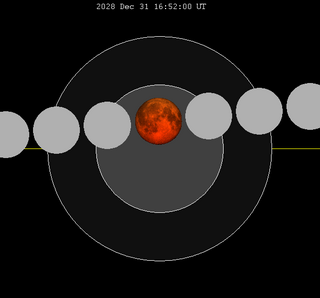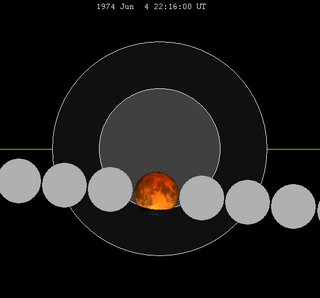
A partial lunar eclipse took place on Friday, September 5, 1941. It was a shallow partial lunar eclipse, with less than 10% of the Moon covered in Earth's shadow.

A partial lunar eclipse took place on Friday, September 5, 1941. It was a shallow partial lunar eclipse, with less than 10% of the Moon covered in Earth's shadow.
Aug 31, 1941 = Sunday
Sep 1, 1941 = Monday
Sep 2, 1941 = Tuesday
Sep 3, 1941 = Wednesday
Sep 4, 1941 = Thursday
Sep 5, 1941 = Friday
Sep 6, 1941 = Saturday
Sep 7, 1941 = Sunday
Sep 8, 1941 = Monday
Sep 9, 1941 = Tuesday
Sep 10, 1941 = Wednesday
Sep 11, 1941 = Thursday
Sep 12, 1941 = Friday
Sep 13, 1941 = Saturday
| Ascending node | Descending node | |||||
|---|---|---|---|---|---|---|
| Saros | Date Viewing | Type Chart | Saros | Date Viewing | Type Chart | |
| 102 | 1940 Mar 23  | Penumbral | 107 | |||
| 112 | 1941 Mar 13  | Partial | 117 | 1941 Sep 05  | Partial | |
| 122 | 1942 Mar 03  | Total | 127 | 1942 Aug 26  | Total | |
| 132 | 1943 Feb 20  | Partial | 137 | 1943 Aug 15  | Partial | |
| 142 | 1944 Feb 09  | Penumbral | 147 | 1944 Aug 04  | Penumbral | |
A lunar eclipse will be preceded and followed by solar eclipses by 9 years and 5.5 days (a half saros). [1] This lunar eclipse is related to two total solar eclipses of Solar Saros 124.
| August 31, 1932 | September 12, 1950 |
|---|---|
 |  |

A total lunar eclipse will take place on Sunday, December 31, 2028. It will occur during a blue moon and is the first such eclipse to happen on New Year's Eve and New Year's Day since December 2009, and the first total lunar eclipse on New Year's Day in history. The next such eclipse will be on December 2047.

A total lunar eclipse took place at the Moon's descending node of the orbit on Tuesday, September 16, 1997, the second of two lunar eclipses in 1997. A shallow total eclipse saw the Moon in relative darkness for 1 hour, 1 minute and 30.8 seconds. The Moon was 19.094% of its diameter into the Earth's umbral shadow, and should have been significantly darkened. The partial eclipse lasted for 3 hours, 16 minutes and 28.2 seconds in total. The penumbral eclipse lasted for 5 hours, 8 minutes and 20.1 seconds. The partial eclipse lasted for 3 hours, 16 minutes and 28.2 seconds. The total eclipse lasted for 1 hour, 1 minute and 30.8 seconds. Maximum eclipse was at 18:46:39.1 UTC. The moon's apparent diameter was extremely large because occurred only 3 hours and 21 minutes past perigee. The Moon was only 356,986 km of the Earth at greatest eclipse.
A total lunar eclipse took place on Saturday, May 24 and Sunday, May 25, 1975, the first of two total lunar eclipses in 1975. The Moon was plunged into darkness for 1 hour and 28 minutes in a deep total eclipse which saw the Moon 43% of its diameter inside the Earth's umbral shadow. The visual effect of an eclipse depends on the state of the Earth's atmosphere, but the Moon may have been stained a deep red colour. The partial eclipse lasted for 3 hours and 35 minutes in total. Occurring only 4.4 days after perigee, the Moon's apparent diameter was 0.7% larger than average. The moon was 377,010 km from the Earth at greatest eclipse.
A partial lunar eclipse took place on Friday, July 17, 1981, the second of two lunar eclipses in 1981. The Earth's shadow on the moon was clearly visible in this eclipse, with 55% of the Moon in shadow; the partial eclipse lasted for 2 hours and 43 minutes.
A penumbral lunar eclipse took place on Tuesday, December 20, 1983, the second of two lunar eclipses in 1983. At the maximum eclipse, 89% of the Moon's disk was partially shaded by the Earth, which caused a slight shadow gradient across its disc; this subtle effect may have been visible to careful observers. No part of the Moon was in complete shadow. The eclipse lasted 4 hours and 2 minutes overall.

A partial lunar eclipse will take place on Wednesday, January 12, 2028.

A partial lunar eclipse will take place on Thursday, July 6, 2028.
A penumbral lunar eclipse took place on Tuesday, September 27, 1977, the second of two lunar eclipses in 1977. At maximum eclipse, 90.076% of the Moon's disc was partially shaded by the Earth, which caused a slight shadow gradient across its disc; this subtle effect may have been visible to careful observers. No part of the Moon was in complete shadow. The eclipse lasted 4 hours, 17 minutes and 35.5 seconds overall. Occurring 6.2 days before apogee, the Moon's apparent diameter was 2.2% smaller than average.
A total lunar eclipse took place on Saturday, September 16, 1978, the second of two total lunar eclipses in 1978. The Moon was plunged into darkness for 1 hour, 18 minutes and 39 seconds, in a deep total eclipse which saw the Moon 32.683% of its diameter inside the Earth's umbral shadow. The visual effect of this depends on the state of the Earth's atmosphere, but the Moon may have been stained a deep red colour. The partial eclipse lasted for 3 hours, 27 minutes and 11.6 seconds in total.
A partial lunar eclipse took place on Tuesday, March 13, 1979, the first of two lunar eclipses in 1979. The Moon was strikingly shadowed in this deep partial eclipse which lasted 3 hours, 17 minutes and 40.6 seconds, with 85.377% of the Moon in darkness at maximum.
A total lunar eclipse took place on Thursday, September 6, 1979, the second of two lunar eclipses in 1979. A shallow total eclipse saw the Moon in relative darkness for 44 minutes and 24.7 seconds. The Moon was 9.358% of its diameter into the Earth's umbral shadow, and should have been significantly darkened. The partial eclipse lasted for 3 hours, 11 minutes and 54.1 seconds in total.
A total lunar eclipse took place on Tuesday, November 18, 1975, the second of two total lunar eclipses in 1975. A shallow total eclipse saw the Moon in relative darkness for 40 minutes and 11.1 seconds. The Moon was 6.421% of its diameter into the Earth's umbral shadow, and should have been significantly darkened. The partial eclipse lasted for 3 hours, 29 minutes and 2.1 seconds in total. Occurring only 4.9 days after apogee, the Moon's apparent diameter was 4% smaller than average.
A partial lunar eclipse took place on Thursday, May 13, 1976, the first of two lunar eclipses in 1976, the second being a penumbral lunar eclipse on November 6, 1976. At maximum eclipse, a small bite out of the Moon should have been visible. The eclipse lasted for 1 hour, 15 minutes and 23.8 seconds, with just 12.17% of the Moon in shadow at maximum. Occurring only 1.1 days after perigee, the Moon's apparent diameter 5.4% larger than average.

A partial lunar eclipse took place on Monday, December 10, 1973, the last of four lunar eclipses in 1973, the first was a penumbral lunar eclipse on January 18, the second was a penumbral lunar eclipse on June 15, and the third was a penumbral lunar eclipse on July 15.

A partial lunar eclipse took place on Tuesday, June 4, 1974, the first of two lunar eclipses in 1974.

A penumbral lunar eclipse took place on Friday, June 15, 1973, the second of four lunar eclipses in 1973, the first was a penumbral lunar eclipse on Thursday, January 18, the third being with a penumbral lunar eclipse on Sunday, July 15, and the last being with a partial lunar eclipse on Monday, December 10.
A partial lunar eclipse occurred on Tuesday, July 25, 1972 and Wednesday, July 26, 1972, the second of two lunar eclipses in 1972 with an umbral eclipse magnitude of 0.54271. A partial lunar eclipse occurs when the Earth moves between the Sun and Moon but the three celestial bodies do not form a straight line in space. When that happens, a small part of the Moon's surface is covered by the darkest, central part of the Earth's shadow, called the umbra. The rest of the Moon is covered by the outer part of the Earth's shadow called the penumbra. The moon's apparent diameter was 3.2 arcseconds smaller than the January 30, 1972 lunar eclipse.

A penumbral lunar eclipse took place on Thursday, January 18, 1973, the first of four lunar eclipses in 1973, the second being with a penumbral lunar eclipse on Friday, June 15, the third being with a penumbral lunar eclipse on Sunday, July 15, and the last being with a partial lunar eclipse on Monday, December 10.

A penumbral lunar eclipse took place on Sunday, July 15, 1973, the third of four lunar eclipses in 1973, the first was a penumbral lunar eclipse on Thursday, January 18, the second was a penumbral lunar eclipse on Friday, June 15, and the last being with a partial lunar eclipse on Monday, December 10.
A penumbral lunar eclipse took place on Wednesday, April 2, 1969, the first of three penumbral lunar eclipses in 1969, the second being on Wednesday, August 27, and the last being on Thursday, September 25. This subtle penumbral eclipse may have been visible to a skilled observer at maximum eclipse. 70.337% of the Moon's disc was partially shaded by the Earth, which caused a gentle shadow gradient across its disc at maximum; the eclipse as a whole lasted 3 hours, 43 minutes and 46.9 seconds. Occurring only 4.2 days before perigee, the Moon's apparent diameter was 0.9% larger than average.